�
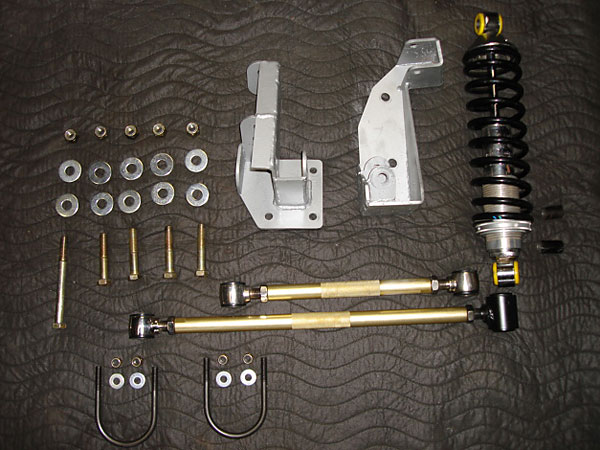
�
New MGB 4-Link Rear Suspension from Classic Conversions Engineering
� The British V8 Newsletter, Volume XV Issue 3, December 2007�� by: Curtis Jacobson�
�
Background
��
What are the weakest links of the original MGB? Many critics would answer the rear suspension.�
It's not a question of durability - the main issue is ride quality. Looking over old MGB magazine �
reviews (including most of the MGB GT V8 articles we've reprinted in this issue of the Newsletter) �
you'll notice that complaints about ride-quality were one of biggest and most persistent gripes �
about MGBs in their day. Especially at low speeds, road shock comes right up through the leaf �
springs and into the driver's spine. The problem is worse when an engine transplant is performed. �
Stock leaf springs are ill-equipped to deal with increased engine torque. The usual result is �
noticeable "axle tramp" on acceleration. As the front sections of the leaf springs wind up and �
unwind, they're also subject to premature sagging and/or leaf breakage. �
�
MG was aware of the ride issue long before the first MGB was even built. According to an �
interview of MGB designer Don Hayter (which I found in Ken Smith's excellent little book �
"Aspects of Abingdon" as published by MG World, copyright 2006), the very first MGB prototype �
was fitted with a trailing arm and coil spring rear suspension that included a Panhard rod �
for side-to-side axle location. A similar suspension had been installed on MGA developmental �
vehicles. The factory engineers preferred coil spring suspension over leaf springs to achieve �
a smoother ride. Ultimately though, MG engineers were unable to overcome a slight steering �
effect caused by fitting a too-short Panhard rod. The "ox cart" leaf spring suspension they �
ultimately carried over from the MGA was "cheap and cheerful", but many of us have been �
tempted to upgrade or replace it.�
- �
- It's difficult to finely adjust ride height on a leaf spring suspension. �
- It's a pain to readjust ride height as the leaf springs sag over time. �
- Easy ride height adjustability makes rubber-to-chrome bumper conversions easier. �
- Maybe you'd like to tune "corner weight" loading to balance the car side-to-side? �
- Today's stickier tires let us corner harder, which calls for better side-to-side axle location. �
- Our taller, wider tires may rub against our fenders unless we improve side-to-side axle location �
- Leaf springs are heavy. (Insert your favorite Colin Chapman quote here... Besides, the heavy weight of the
� leaf springs and axle forced MG to use uncomfortable shock dampening characteristics in the first place.) �
- If we have axle tramp, we're losing acceleration potential and we're risking dangerous leaf spring failure. �
- If we fit low profile tires, we don't get as much shock absorption in the tire sidewall. �
- With hi-torque engines and overdrive, we need to change axle ratio and we want a limited slip differential.
� The most economical way to get these is usually a narrowed American-made axle. When we fit that
� narrowed Ford, GM, or Dana axle we'll probably need to adjust axle pinion angle too. �
�
The all new Classic Conversions Engineering "4-link" rear suspension addresses all these issues�
quite elegantly, and it even addresses them without a Panhard rod. �
�
�
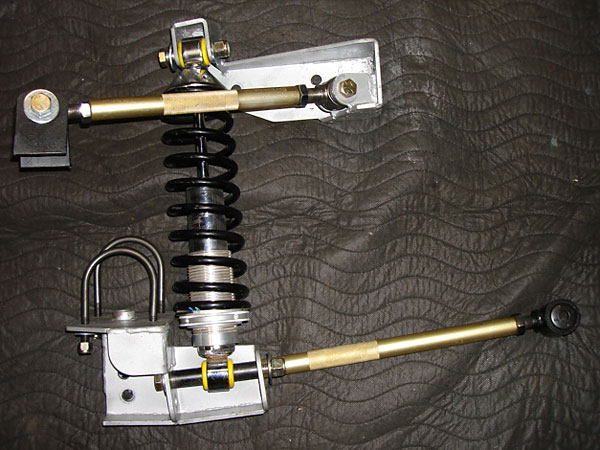 �
�
Features of the Classic Conversions 4-link Rear Suspension
��
The Classic Conversions 4-link rear suspension features coilover shock absorbers in lieu of �
heavy leaf springs and the MGB's original Armstrong knee-action shock absorbers. As soon as �
your UPS guy delivers the box, you'll know there's a big weight difference! The suspension's �
creator, Bill Guzman, advises us that the Classic Conversions 4-link suspension weighs about �
47 pounds less than a stock MGB rear suspension. �
�
As soon as you see the coilover shocks and their mounting brackets, you'll understand another �
of his suspension's biggest selling points. It facilitates exceptionally easy adjustment and �
fine-tuning of ride height. Ride height can be adjusted by placing the shock in either one of �
two mounting holes on the axle bracket. The lower position nominally places the car 1" below �
stock ride height. Subsequently, ride height can be precision adjusted by rotating the threaded �
lower spring perch on the coilover shock absorber's body. According to Bill, with the spring �
perch threaded to its lowest position, your car's static ride height should be two inches below �
a "chrome-bumper" MGB's factory-original ride height. �
�
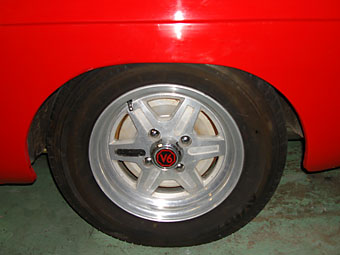 �
�
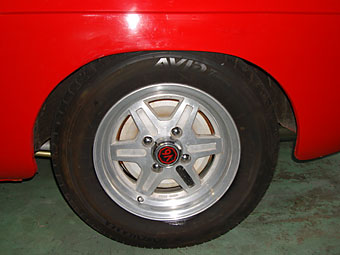
�
These two photos show the suspension's lowest and highest static height settings. �
� Bill also advises that Classic Conversions will introduce a new, matching MGB front � suspension next spring that will be similarly adjustable at the front of the car. Although � most of us are content to just level (and lower) the ride height and leave it at that, easy � adjustability at all four corners will allow some of us to equalize "corner weights" to get � the very most traction out of our tires (for competitive autocrossing, etc.)�
��
Enjoying this article? Our magazine is funded through the generous support of readers like you!
�
To contribute to our operating budget, please click here and follow the instructions.
�
(Suggested contribution is twenty bucks per year. Feel free to give more!)�
�
The Classic Conversions Engineering 4-link rear suspension also facilitates four wheel �
alignment. In other words, you or your alignment shop can easily adjust the suspension to make �
sure the rear axle is tracking straight. You can also easily adjust the rear axle's pinion �
angle, or dial in a little bit of anti-squat characteristic to the rear suspension. �
�
Want easily adjustable shock absorber valving too? The coilover shock absorbers that are �
standard equipment with the kit are made by Carrera, but Alden aluminum adjustable �
coilovers are available at an additional cost.�
�
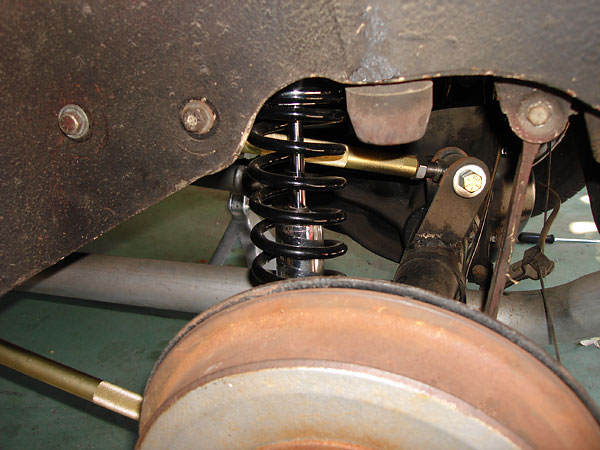
�
The Classic Conversions 4-link is designed to be simple to install. Only a minimal amount of welding
�
is required, and the welds in question (shown here) are of heavy gauge brackets to the top of the axle
�
tubes. If you're not comfortable welding, this job wouldn't be very expensive to farm-out locally.
�
Easy Installation - Suits a Broad Range of Applications
��
The Classic Conversions 4-link rear suspension is designed to be installable in one �
afternoon. (Whether this is really possible will depend on what's in the way. You �
may have to alter your exhaust system, etc.) The design utilizes the MGB's front leaf �
spring mounting holes, and the bolt holes for the old knee-action shocks. Just to set�
the record straight for purists: this installation is completely "reversible". �
�
This design should also work equally nicely with all the popular stock and aftermarket �
axles: either MGB's "banjo" or Salisbury axles, and with either lugged or splined hubs, �
plus also narrowed Ford, GM, or Dana axles. �
�
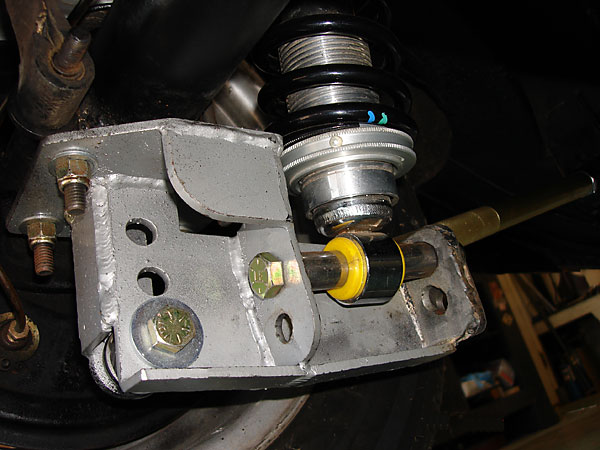
�
Designed for serviceability...
�
�
Although the system is durable and intended to last for years without modification, �
it's also designed to be easily serviceable. Spring changes, for example, are just a �
matter of unbolting the bottom bolt of the shock, unscrewing the spring-perch nut, and �
replacing the spring.�
�
The coil spring for the GT has a nominal rating of 160 lbs per inch, and the coil �
spring for the roadster has a nominal rating of 140 lbs per inch. Both GT and �
roadster kits utilize the same shock absorber valving. �
�
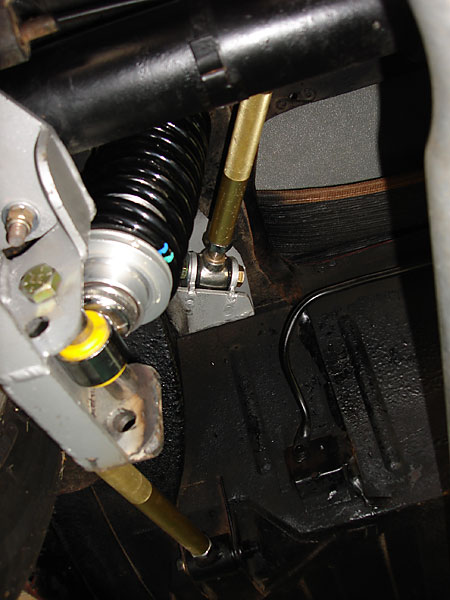
�
Top links are angled inward...
�
� All four of the suspension links are custom made out of gold anodized 6061-T6 aluminum. � The links feature 5/8" threaded stainless-steel rod-ends with urethane bushings, and they � have right-hand threads at one end and left-hand threads at the other for easy adjustability. � So long as the rod-ends don't bind up, the rods can only be loaded along their axis, in� tension or compression. The rods are sufficiently strong to eliminate axle tramp (assuming � that the rear axle itself is rigid). �
�How Does It Function?
��
Notice in the photos that the top pair of links are angled-in toward the center of the axle.�
This design was chosen to make a Panhard rod unnecessary. Working together, the two links �
should positively locate the axle from side-to-side. Of course there will be some side-to-side �
motion due to compliance in the rubber bushes, but compared to the original MGB suspension �
the car should feel more secure on turns, tire scuffing on the wheel wells or fender-lips�
should be avoided, and you may be able to fit wider tires. �
�
Let's digress and review for a moment what a Panhard rod is and how it functions. A �
Panhard rod is a single link mounted parallel to the rear axle with one end mounted to �
the axle and the other end mounted to the frame or body of the car, usually for the sole �
purpose of keeping the axle centered. Panhard rods can be made to work great, and they're �
both simple and cost-effective - but they can also cause problems! Think for a moment of �
the axle end of the Panhard rod as being positively fixed in space, with the rest of �
the rod free to pivot around it. When the car goes over a bump, the body end of the Panhard �
rod must move up and down relative to the axle. Since the rod is rigid and has a fixed length, �
the body also gets shoved a little bit side-to-side as the rod-end swings through an arc.�
A longer Panhard rod induces less side-to-side motion for a given amount of up-and-down �
motion. (Take a ruler and compass to some paper if you need to prove this to yourself.) �
Thus, Panhard rods should always be as long as feasible!�
�
By not using a Panhard rod, the Classic Conversions 4-link has avoided the induced �
steering effect on bumps that MG engineers reportedly had with their coil-sprung rear �
suspension prototypes. �
�
Another inherent feature of the new Classic Conversions suspension is "anti-squat". �
Bill tells us that the suspension links have been deliberately angled to counteract �
compressive force at the rear springs as the weight of car shifts rearward. The result �
will be added traction and improved acceleration when exiting corners. �
�
Speaking of cornering, how does the suspension react to body roll in turns? Does the �
geometry of the suspension cause the rear axle to cock slightly to one side, thus causing �
"roll steer"? When just one rear wheel hits a bump, will the driver need to make a steering �
correction due to "bump steer"? If there is indeed a roll steer effect, how strong �
is it? Does the effect tend toward "under steer" or "over steer"? �
�
Bill advises that the Classic Conversions 4-link has a slight roll steer characteristic �
which is in the direction of over steer. In other words, as the body pitches in a turn �
it will tend to cause the car to steer a tighter line.�
�
Later model MGB axles were equipped with a rear anti-sway bar. It was mounted just above �
and parallel-to the axle and its two arms extended forward to mounts on the body. �
(Click here to see �
what these anti-sway bars looked like.) If your car is equipped with this style �
anti-sway bar, it will need to be removed before the top links of the suspension can �
even be installed. The new 4-link rear suspension was designed to be used without a �
rear anti-sway bar. �
�
Bill has rigged up a static roll-test and been unable to induce binding in any suspension �
pivot through the full travel of the suspension. All of the bolted joints in the �
suspension are in double-shear. The suspension is provided with all the SAE Grade-8 �
hardware required for installation.�
�
The Classic Conversions four-link rear suspension kit is priced at $1,228, plus shipping. �
Through March 31, Classic Conversions is offering a special introductory discount price �
of just $1103, plus shipping. With optional Alden shocks instead of the standard Carrera, �
add $180.
�
�
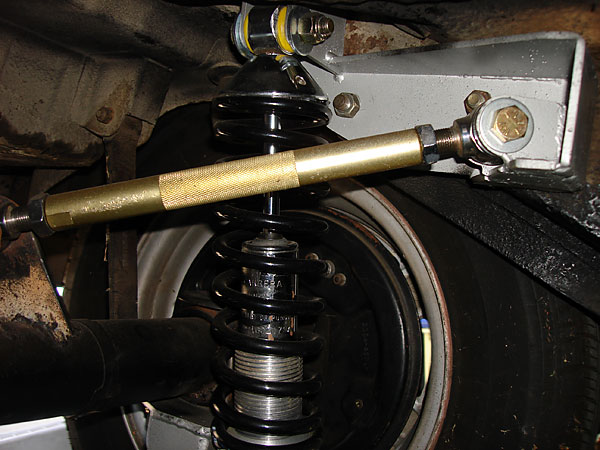
�
The upper chassis mount uses the old shock absorber mounting holes.
�
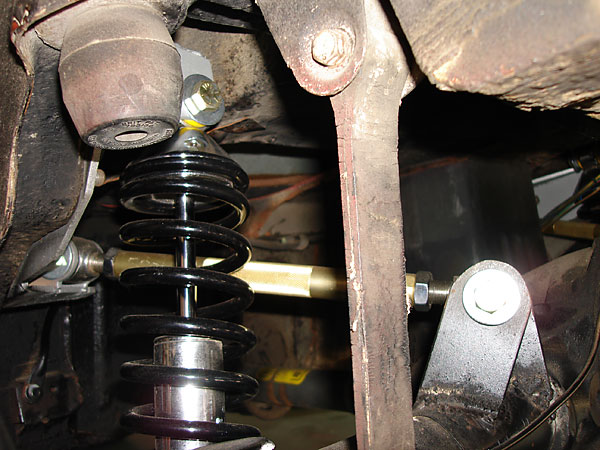
�
Stock bump stops and rebound straps can be left unchanged.
�
(For added safety, when you weld the mounting tabs onto your axle you may want to weld a simple
�
reinforcement strap or two between them to reduce the likelihood of fatigue cracking in the welds.)
�
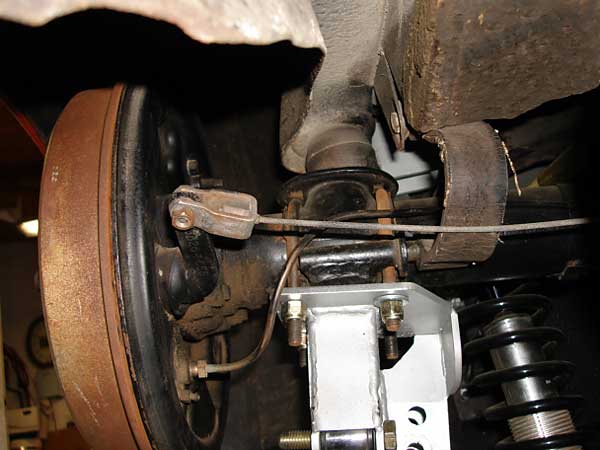
�
The Classic Conversions 4-link provides a full range of suspension travel without binding.
�
(The lower end of the shock absorber has been disconnected for this demonstration photo.)
�
� Photos by Bill Guzman. All rights reserved. �


